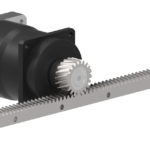Rack and pinion drives are often used in applications that require stroke lengths beyond the practical limits of ball screws and thrust forces that exceed the capabilities of belt drives. And in some applications, rack and pinion systems can also provide lower total inertia than a suitable ball screw or belt drive alternative, which can […]
Rack + pinion sets
Mechanical properties of materials: Hardness
Hardness is a common specification for linear shafts and guides — especially those used with ball and roller bearings, where the guide encounters extremely high loads over very small areas. The hardness of a bearing surface can significantly affect the life of the system and is often accounted for by applying a hardness correction factor […]
What are some linear motion options for moving multiple loads independently?
From a mechanical standpoint, one of the more challenging applications in linear motion has traditionally been to move two or more loads independently, as is required in some handling, transport, and inspection applications. While using multiple linear systems, or preassembled actuators, is a simple solution mechanically, this option typically requires a significant amount of space […]
The difference between rack-pinion module and diametral pitch
Gear sizes are typically specified by one of two designations: Module or diametral pitch. While both specifications define the size of the gear teeth, module and diametral pitch are calculated differently, with module (sometimes referred to as metric pitch) being the metric sizing standard and diametrical pitch being the Imperial (inch) sizing method. Standard […]
Top 10 considerations when applying rack and pinion systems
Rack and pinion systems are excellent electromechanical devices uniquely suited for achieving a linear or rotary motion solution mostly unattainable with other technologies. The typical system is made up of long straight rack (or linear gear) with teeth on one surface, a matching pinion (or circular gear), and a method for driving one or the […]
What are low outgassing materials for linear motion components in vacuum applications
Outgassing — the release of gas or vapor from a material through desorption, sublimation (the transition of a material from solid directly to gas), or evaporation — is a critical parameter for materials used in vacuum environments. These gasses and vapors can affect the pressure (or level of vacuum) in the vacuum chamber, and outgassed compounds […]
The top 10 linear motion articles of 2020
Suffice it to say, pretty much everything about 2020 has been out of the ordinary, and our recap of the top linear motion articles for this year is no exception. For the first time in recent history, only one (1!) of the top 10 articles is about ball or lead screw technologies — a topic that usually […]
Güdel gantry robots add gentle touch to bakery automation
In the U.S., about 50 million people a day eat at fast-food restaurants — and about 60,000 of those establishments sell hamburgers. That requires epic volumes of fresh buns every day … and only commercial bakeries with automated operations can output sufficient production volumes. Workhorse Automation Inc. (based in Oxford, Pa.) supplies machines to this […]
New rack and pinion systems available from GAM Enterprises
GAM now offers new helical rack and pinion systems. High quality rack and precision pinions are paired with GAM gearboxes for optimized system performance. Helical rack provides smooth, quiet operation and precision operation. The rack is available in 1-meter lengths in module 2, 3, or 4 and ISO quality 6 or 10. Precision pinions in […]
How to size a rack and pinion drive
In linear motion applications, ball screws are widely recognized for their ability to provide high thrust forces, while linear motors are gaining market share in high-speed applications, and belt drives continue to maintain their reputation as the best solution for long travel lengths. But rack and pinion drives are the often-overlooked workhorses behind gantry and […]











